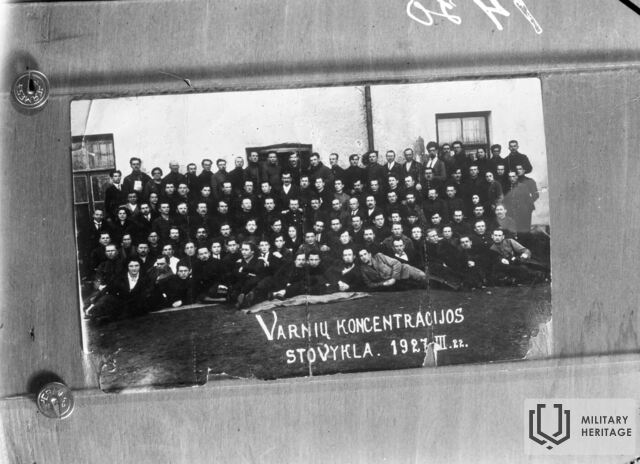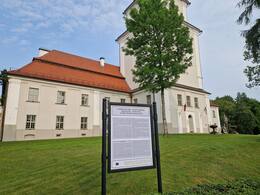Varniai concentration camp
Independence of the Baltic States
The Varniai concentration camp was established at the end of December 1926, immediately after the December 17 coup, on the initiative of the Minister of National Defence Antanas Merkys. The camp was located in buildings that had previously belonged to the Samogitian Diocese and operated until October 1931 (formally until the second half of 1932).
The camp was established on the basis of the Special Statutes of State Security, supplemented in 1920, which gave military commandants the right to administratively send persons suspected of being dangerous to state security to concentration camps. It was subordinate to the Ministry of National Defence and had a team of 50-65 soldiers. The camp was led by commandant Kostas Rudaitis (1927-1931).
Various people were sent to the camp: communists, activists of the Lithuanian Social Democratic Party, the Lithuanian Peasants' People's Union, the Lithuanian Christian Democratic Party and other public organizations, partisans and people who criticized the nationalist government. Among the more prominent prisoners were the former Minister of Finance, one of the leaders of the Christian Democrats Petras Karvelis, the chairman of the Labor Federation Dr. Kazimieras Ambrozaitis, and the founder of the Social Democratic Party Andrius Domaševičius. At the beginning of the camp, petty hooligans, hot-tempered youths or vagrants were also sent here.
The so-called internees could be held in the camp from 3 months until the end of martial law. Communists were usually given the maximum sentence. In 1927-1931, more than 1,000 people were imprisoned in the camp, and at one time up to 190 people. There were especially many prisoners after the Tauragė putsch in 1927 (up to 150 people). At the beginning of 1927, there were 120 people in the camp, and by the end of the year there were already 187.
Daily life in the camp was quite monotonous. The main duties of the prisoners were to prepare food, chop firewood, light the stoves and maintain order in the cells. Interestingly, at the beginning of the camp's operation, these tasks were performed by the officers themselves, which the communist prisoners were indignant about in their appeals. Boleslovas Baranauskas stated that "the removal of the internees from work, the lack of activity was a result of the administration's deliberate choice of psychological suppression of hardworking people from the proletariat."
The prisoners were given a lot of freedom in the camp. There was a small library, during the day the prisoners could freely walk around the yard, read and play chess, and the cells were usually not locked. Out of boredom (because, unlike in the later Dimitrava or Pabradė camps, there was no work required here), the prisoners sometimes climbed up to the windows and sang communist, revolutionary songs. During socialist holidays, red flags even appeared in the camp.
According to the memories of prisoners at that time, the camp cells were huge, accommodating 30 or more people, with two rows of wooden bunks along the walls. As the communist Boleslovas Baranauskas writes in his memoirs: "The cells are huge, they could accommodate 30 or more people. Inside, wooden bunks in two rows were lined up all over the room, you could only pass along the edges of the walls." And Jeronimas Plečkaitis and the so-called Plečkaitis in their newspapers depicted Varniai as a place where "about 200 people are crammed into the damp walls of a concentration camp, a large part of whom have been sitting for three years without trial, without interrogation, without any imprisonment."
Although there were incidents in the camp (for example, in 1927, five communists were sentenced to death for incitement and mistreatment in the camp, but their requests for clemency were granted), the conditions here were relatively mild, especially compared to the concentration camps of the fascist states of the time. The communists even managed to give ideological lectures to other prisoners. When the camp was closed, the authorities even complained that it had not been effective: the communists were supposedly fed unusually well, well maintained, and felt quite comfortable, and they even agitated other prisoners.
The camp was closed in October 1931 due to economic difficulties. It was one of three such institutions operating during the authoritarian regime (1927-1940) – it was followed by the Dimitrava forced labor camp (from 1936) and the Pabradė camp (from 1939). In the later camps – Dimitrava and Pabradė – prisoners had the opportunity to read newspapers and listen to the radio, but they also had to work harder than in Varniai.
More information sources
Related timeline
Related objects
Museum of the Diocese of Samogitia
The Samogitian Diocesan Museum is a division of the Samogitian Museum "Alka", established in 1999 in the former Varniai Samogitian Seminary building, built in 1770.
The museum presents the artistic, historical and memorial heritage of the Samogitian (Medininkai) Diocese and the Telšiai Diocese (since 1926). The museum is housed in the building of the former Samogitian seminary, built in the 18th century for the administration of Tsarist Russia.
The seminary operated until 1864. After the uprising of 1863-1864, the seminary and part of the diocesan building were transferred to the Russian Empire's army and began to be reconstructed, adapting them to a new - military - purpose, which the seminary building would serve for several subsequent decades. In 1871, the Don Cossack regiment, which was transferred to the 33-building complex formed in Varniai, remained in Varniai until 1905.
After regaining independence, the Lithuanian Army Discipline Company and the Eighth Infantry Regiment of Kaunas Duke Vaidotas were based in this place. During the interwar period, the Varniai concentration camp operated in the museum buildings (1927-1931). During the Soviet era (1947), the Varniai secondary school was located here, later the building was transferred to the Varniai village vocational technical school. After the restoration of Independence, in 1995. the bell tower and the original roof structure, typical of the late Lithuanian Baroque, were rebuilt. In 1999, the building was transferred to the Samogitian Diocese Museum.
Related stories
Varniai Camp: Where Communists and Christian Democrats Played Chess
The Varniai concentration camp, which operated from 1926 to 1931, became a special place where communists, Christian Democrats, and even petty hooligans were imprisoned together - anyone who could pose a threat to the Smetona regime.






